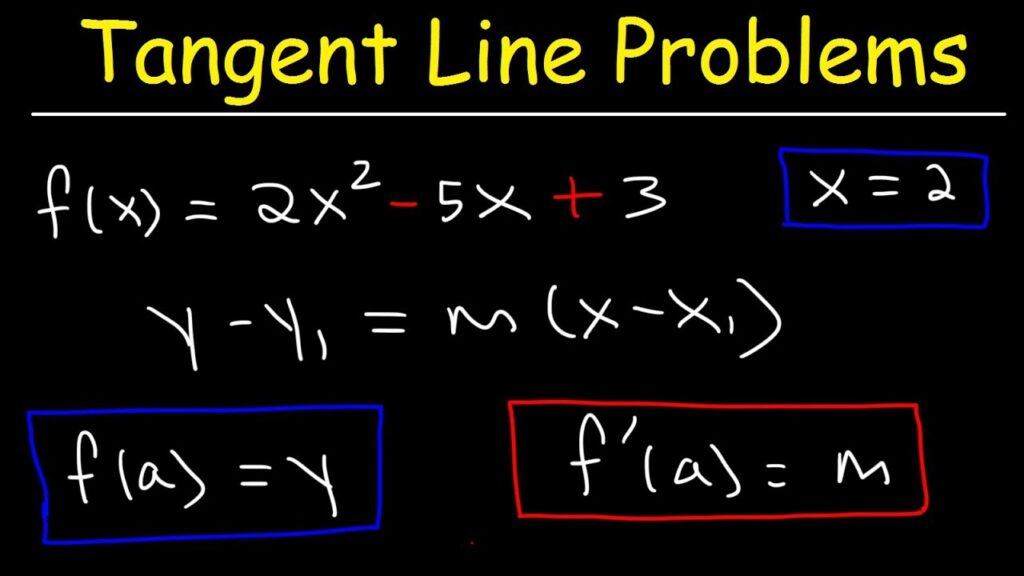Understanding the Tangent Line
Definition of a Tangent Line
A tangent line is a straight line that touches a curve at a specific point without crossing it. This line represents the instantaneous direction of the curve at that point. The slope of the tangent line is given by the derivative of the function at that point.
Importance of Tangent Lines
Tangent lines are crucial in various fields, including physics, engineering, and economics. They help in understanding how a function behaves locally, allowing for approximations of function values near the point of tangency.
Steps to Find the Tangent Line
To find the equation of the tangent line to a curve at a specific point, follow these steps:
Step 1: Identify the Point of Tangency
Suppose we have a function f(x) and we want to find the tangent line at the point x=a. First, calculate the y-coordinate of the point of tangency:
Thus, the point of tangency is (a,f(a)).
Step 2: Find the Derivative
Next, calculate the derivative of the function, f′(x). The derivative gives us the slope of the tangent line at any point x on the curve.
Step 3: Evaluate the Derivative at the Point
Substitute x=a into the derivative to find the slope of the tangent line at that point:
Step 4: Use the Point-Slope Formula
Now that we have the slope m and the point (a,f(a)), we can use the point-slope formula to write the equation of the tangent line:
This equation can be rearranged into slope-intercept form y=mx+b if desired.
Example 1: Finding the Tangent Line
Let’s find the tangent line to the function f(x)=x2 at the point x=2.
- Identify the Point of Tangency:
f(2)=22=4
So, the point is (2,4).
- Find the Derivative:
f′(x)=2x
- Evaluate the Derivative at the Point:
f′(2)=2(2)=4
The slope m=4.
- Use the Point-Slope Formula:
y−4=4(x−2)
Simplifying gives:
y=4x−4
Thus, the equation of the tangent line at the point (2,4) is y=4x−4.
Example 2: Finding the Tangent Line to a Trigonometric Function
Let’s find the tangent line to the function f(x)=sin(x) at the point x=π2.
- Identify the Point of Tangency:
f(π2)=sin(π2)=1
So, the point is (π2,1).
- Find the Derivative:
f′(x)=cos(x)
- Evaluate the Derivative at the Point:
f′(π2)=cos(π2)=0
The slope m=0.
- Use the Point-Slope Formula:
y−1=0(x−π2)
Simplifying gives:
y=1
Thus, the equation of the tangent line at the point (π2,1) is y=1.
Summary of Key Points
| Step | Description |
|---|---|
| Identify Point | Find the point of tangency (a,f(a)) |
| Find Derivative | Calculate f′(x) for the function |
| Evaluate Derivative | Find the slope at the point m=f′(a) |
| Point-Slope Formula | Use y−f(a)=m(x−a) to find the tangent line |
Applications of Tangent Lines
Physics
In physics, tangent lines are used to determine instantaneous velocity. For a position function s(t), the derivative s′(t) gives the velocity at time t.
Economics
In economics, tangent lines can represent marginal cost or marginal revenue. The slope of the tangent line to a cost function at a certain production level indicates the additional cost incurred by producing one more unit.
Engineering
In engineering, tangent lines help in designing curves and understanding stress and strain in materials. They provide insights into how structures will behave under various loads.
Advanced Concepts Related to Tangent Lines
Normal Lines
The normal line to a curve at a given point is perpendicular to the tangent line. If the slope of the tangent line is m, the slope of the normal line is given by:
Higher-Dimensional Tangents
In higher dimensions, the concept of tangent lines extends to tangent planes in multivariable calculus. For a surface defined by z=f(x,y), the tangent plane at a point (x0,y0) can be found using partial derivatives.
Implicit Differentiation
When dealing with implicit functions, where F(x,y)=0, the derivative can be found using implicit differentiation. This technique allows for finding the slope of the tangent line without explicitly solving for y.
Conclusion
Finding the tangent line to a curve is a fundamental skill in calculus that has numerous applications across various fields. By following the outlined steps, anyone can determine the equation of a tangent line at a specific point on a curve. Understanding this concept not only enhances mathematical skills but also provides valuable insights into real-world applications.
FAQ Section
Q1: What is a tangent line?
A1: A tangent line is a straight line that touches a curve at a specific point without crossing it, representing the instantaneous direction of the curve at that point.
Q2: How do I find the slope of a tangent line?
A2: The slope of the tangent line at a point is found by calculating the derivative of the function and evaluating it at that point.
Q3: What is the point-slope formula?
A3: The point-slope formula is y−y0=m(x−x0), where (x0,y0) is a point on the line and m is the slope.
Q4: Can I find tangent lines for functions that are not differentiable?
A4: No, a tangent line can only be defined at points where the function is differentiable. If the derivative does not exist, the tangent line cannot be determined.
Q5: What is the difference between a tangent line and a normal line?
A5: A tangent line touches the curve at a point, while a normal line is perpendicular to the tangent line at that same point.
Additional Resources
For further information on tangent lines and calculus concepts, you can refer to the Wikipedia page on Tangent Line or resources from educational institutions that cover calculus topics.



